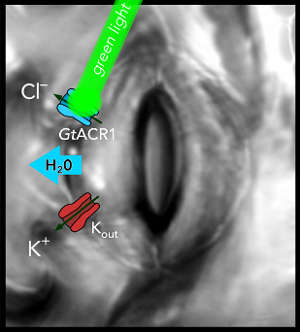Using AI to control energy for indoor agriculture
30 September 2024
Published online 19 July 2021
A light-sensitive protein switch prompts plants to close leaf pores quickly under drought conditions, improving their chances of survival.

Rob Roelfsema, 2021
Enlarge image
Stomata are tiny pores on the surfaces of leaves and stems that open and close to allow water, carbon dioxide and oxygen to enter and escape the plant’s tissues and cells. Guard cells spanning the stomata pore control the aperture by responding to complex cellular signalling cues. Under drought stress, shifts in the flow of ions from the guard cells cause their internal pressure to drop, prompting stomata to close. Disruption to this mechanism can lead to plant death.
“Scientists have long hypothesized that anion channels expressed in guard cells are involved in stomatal closure,” says Rainer Hedrich at the University of Würzburg, Germany, who worked on the study alongside colleagues, and scientists in Chile and Saudi Arabia. “We explored this theory using optogenetic techniques, making use of light-gated ion channels that have proved valuable in neurobiology.”
The team used a natural, light-sensitive anion channel protein called GtACR1, sourced from an alga, and generated tobacco plants with high expression of this protein in their guard cells.
“GtACR1 allowed the plants to ‘see’ green light, which they would not normally respond to,” says Hedrich. “The plants were grown under red light to keep GtACR1 silent to begin with.”
In response to pulses of green light, the protein switched on and stimulated flow of chloride and then potassium out of the guard cells, causing them to lose pressure. This closed the stomata and prevented transpiration from the plant leaves almost entirely, enabling the plants to survive drought conditions.
“This shows that anion channels are key players in stomatal closure,” says Hedrich. “Using light flashes could bypass the complex signalling network required to activate intrinsic anion channels. Plants could be cultivated to express high levels of light-sensitive anion channels to boost their drought tolerance.”
However, making this leap is a considerable challenge and would involve making the light switch work ‘on demand only’ under natural sunlight conditions. The researchers are planning further experiments using optogenetics to explore control of plants’ natural anion channels.
“This technology opens doors to investigate other cell types too,” Hedrich adds. “Plants use long-distance signalling to prepare for threats from pathogens and pests. We could express light-gated channels in cells involved in the plant’s electrical network to examine how plants defend themselves.”
doi:10.1038/nmiddleeast.2021.65
Huang, S. et al. Optogenetic control of the guard cell membrane potential and stomatal movement by the light-gated anion channel GtACR1. Sci. Adv. 7,28 eabg4619 (2021).
Stay connected: